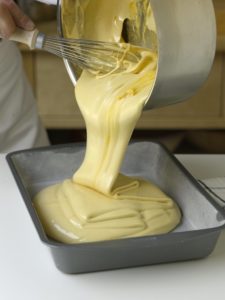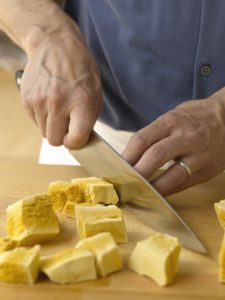You may think Buffalo, New York stopped when it perfected the spicy Buffalo wing, but you might be surprised to find out that the wing is arguably the second-best food to come out of the city.
For the sweet-toothed among us, Buffalo’s very best regional specialty has an unfortunate name that luckily doesn’t inhibit its appeal among locals. Sponge candy is not spongy in the least bit. In fact, it’s incredibly crunchy with an airy, honeycomb-style interior.
It is a specialty of the region, and the area in far west New York state at the southern edge of Lake Erie has actually been referred to as the Sponge Candy Crescent. What a legacy (sincerely!).
Sponge candy is a very old-fashioned sweet that goes by many different names. Whether you know it as sponge candy, cinder block, fairy food, or seafoam, sponge candy is always a slightly caramelized sugar mixture lightened into a foam by the addition of baking soda; it has a unique, delicate, crispy texture and a distinctive flavor of caramel with a hint of honey.
Abroad, sponge candy is a center for at least two candy bars, one made by Cadbury (Crunchie) and one made by Nestlé (Violet Crumble); these are sold primarily in Britain and Australia, respectively. Whether you have a mass-produced version, a local candy maker’s, or make it in your own kitchen, those who know and love it always appreciate sponge candy.
What’s in it, you ask? Sponge candy contains few ingredients. It is unique among aerated candies because it is lightened by the addition of a chemical leavener, baking soda, rather than by whipping an aerator such as egg whites or gelatin.
- Gelatin: A very small amount of gelatin used in sponge candy helps to make the hot syrup more elastic and therefore able to hold more of the gas from the baking soda, resulting in a lighter candy.
- Sugar: Providing sweetness, caramelization, and bulk, sugar is the major ingredient in sponge candy, as in most candies.
- Corn Syrup: The addition of corn syrup helps to prevent sponge candy from crystallizing, in addition to providing sweetness and caramelization.
- Honey: An optional ingredient in sponge candy, honey may be present in small quantities, purely for flavor.
- Baking Soda: Well known as a leavener in baked goods, the baking soda releases CO2 gas when added to the hot sugar mixture, which immediately foams up and forms the unique spongy texture that is the hallmark of the candy. Baking soda should always be sifted before being added to sponge candy.
Making sponge candy is not much more difficult than cooking sugar, but preparation is essential to ensure good results. Always prepare the pan before you begin cooking the sugar, use a saucepan that allows for expansion once the baking soda is added, and be careful not to disturb the sponge candy while it is in the crucial cooling stage, or it may collapse.
- Hydrate the gelatin in cold water. There is no need to melt the gelatin; the hot sugar will do that for you.
- Combine the sugars and water in a saucepan and cook. The sugar mixture is cooked to hard crack stage (this means enough sugar has been cooked out of the mixture so that when it cools, it will be hard and firm enough to crack if bent) to ensure that the candy will be crisp when it is finished. When using honey, it is usually added late in the cooking to prevent burning.
- Remove from the heat and allow to cool slightly. A slightly cooler sugar mixture will hold aeration better than one that is scorching hot.
- Stir in the hydrated gelatin. You will immediately notice that the sugar becomes elastic. Be sure the gelatin is thoroughly mixed into the sugar.
- Whisk in the sifted baking soda. Whisk vigorously to ensure that the soda is thoroughly mixed into the sugar and that no lumps form. Return briefly to heat.
- Immediately pour into the prepared pan. The foamy sugar should still be rising when it goes into the pan.

- Allow to cool undisturbed until thoroughly cooled. This will take at least a couple of hours, and it is fine to leave it overnight, as long as it is protected from humidity.
- Break or cut into pieces and dip in chocolate, if desired. Home candy makers usually do not attempt to cut regular-shaped pieces from sponge candy; they break it into irregular chunks. Dipping in chocolate is optional, but the chocolate not only provides flavor, it protects the sponge candy from humidity.

Like most sugar candies, sponge candy is very easily ruined by exposure to humidity. Once the pieces are coated in chocolate, they are safe from moisture in the air, but before coating, every effort must be taken to prevent moisture or humidity from damaging the sponge candy. Tightly sealed plastic bags or containers are the best method to avoid this environmental damage.
